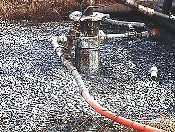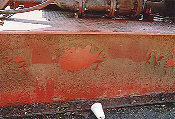New additive provides inexpensive solution to well and facility cleanup
New additive provides inexpensive solution to well and facility cleanupLyle D. Burns and James W. Reynolds (jrtulsa@aol.com), Terra Environmental Products Co., Bartlesville, Okla. Larry Selby, Independent Producer, Bartlesville, Okla. Don Richard, Dresser-Rand, Broken Arrow, Okla. Bottom line. Field performance tests have confirmed that a process to render most hydrocarbons non-hazardous can provide a fast, safe and economical way to remediate "typical" spills and leaks, and also clean field equipment. Overview. For both operators and service companies, well and equipment cleanup is important not only for environmental reasons, but also because clean, well-maintained leases are viewed by many as evidence of responsible operations. Terra Environmental Products Co. (TEPCO) has developed a cost-effective process to render most hydrocarbons non-hazardous and below U.S. EPA standards. When traditional cleanup treatment methods are used, soil and gravel are removed, disposed of and replaced — an expensive process. In addition, cleaning the steel surfaces (whether they are on the well and lease or on equipment, such as rental compressors) requires the use of a "hazardous" solvent, which can create problems if it reaches the ground. However, Terracap additives were used to clean up two well sites in Oklahoma. This two-part silica-based technology micro-encapsulates most hydrocarbons upon contact and renders them non-hazardous (either non-detectable or below EPA hazardous levels). Since the operator’s objective in this case study was pollution prevention and the removal of visual hydrocarbons, residue tests were not conducted. If this had been a remediation project in Oklahoma, all that would have been required by the State Corporation Commission was proof that the soil would support vegetative growth. In other states, a TCLP extraction (EPA method 1311) followed by a TPH analysis (EPA method 8015-m) and BTEX analysis (EPA method 8020) would be required to prove the residue is in compliance with state regulatory standards. The Texas Railroad Commission, for example, requires detectable TPH at or below 10,000 ppm after treatment. A previous test on sandy loam soil contaminated with 4,010 ppm (mid 30°API gravity) crude oil showed 1 ppm leachable hydrocarbons with BTEX well below the limits after treatment with the additives. Similar tests were conducted on bulk samples of used motor oil. Detectable TPH was reduced from 870,000 ppm before treatment to less than 7 ppm after treatment. These tests can be conducted by any EPA certified lab for approximately $50 to $100 per test.1 Once treated with these additives, previously contaminated soil and gravel (according to EPA Notice 54FR-41566) can remain on site, substantially reducing cleanup and disposal costs. When sprayed onto steel surfaces, they can be brushed off or washed away. The additives also can remove the dangerous characteristics of waste, such as ignitability, corrosivity, reactivity and toxicity, and convert materials into a non-flammable and permanently non-leachable substance. Treatment areas. The additives were used in two separate applications. The first was a 500-acre lease, operated by independent producer Larry Selby, in Nowata County, Okla. The additives were used to clean two wellheads and part of the tank battery. In the other application, Dresser-Rand used the additives to clean compressor equipment that had been returned after rental. Selby’s lease contained 15 wells, drilled in 1984 and 1985. Wells produce a total of 14 to 20 bopd (32–34°API) from the Bartlesville formation at 1,200 ft. Part of the lease is on grazing land, which shows the effect of natural erosion, especially in shallow ravines or dry washes. The producer wanted to maintain the good relationship with the landowner and the Oklahoma Corporation Commission by eliminating the appearance of possible pollution.
Three areas were of specific concern for the Selby lease. Well 4a has a recession in front of it that lets rainwater run into a dry wash leading to a pond 100 yards away. A fresh stuffing box leak let oil run down the wellhead, creating a 6- to 7-ft trail of oil toward the pond. Well 1 also is next to the dry wash that runs into the pond. A similar fresh stuffing box leak coated the wellhead and 6 sq ft of gravel with dried oil, Fig. 1. There also were spills associated with the tank battery. Drips caused by using the gauge line and pulling grind out samples had coated the railing and walkway, creating a potential safety hazard. In the second application, a Dresser-Rand compressor unit, which had been on location for one year, was brought back to Broken Arrow, Okla., for routine overhaul. A light coating of hydrocarbon material, typical with fluid leaks that occur during normal operations, covered the unit.
Field applications. For the Selby lease, Terracap 3000 was sprayed on the wellhead at Well 4a and agitated with a medium-bristled brush. It also was sprayed on and raked into the soil. The process was repeated using Terracap 4000. The series was repeated 10 min later. Terracap 3000 was sprayed on the wellhead and gravel at Well 1, followed by Terracap 4000. A second treatment also was applied. For the tank battery, a light coat of 3000 was sprayed on the railing, walkway and around the hatch, followed by a light coat of 4000. Although the 3000/4000 was used here, normally the single-stage 2500 treatment is used with old oil on painted steel surfaces. For Dresser-Rand’s skid-mounted compressor, the single-stage Terracap 2500 was sprayed on the compressor. Results. For the Selby lease, the oil on the wellhead of Well 4a was dry after an hour and starting to flake; the oil trail in the soil was no longer visible. Treatment time was 20 to 25 min, and the cost was less than $20. At Well 1, the gravel was completely white and the oil on the wellhead was a dry powder within 30 min, Fig. 2. Total treatment time was 15 min, and the cost was less than $10. After 30 min, the oil film was a dry powder at the tank battery. Treatment time was less than 10 min, and the cost was around $5.
On the compressor, dry, thin flakes of micro-encapsulated oil peeled off within 30 min, leaving behind a clean painted surface, Fig. 3. The dry oil was easily washed off using a pump-up orchard sprayer. No free oil was detected during the wash off process and the material posed no threat to the environment. In addition, when the residue was soaked in water, no oil sheen developed. The cost of materials for cleaning the entire compressor was less than $100, and routine maintenance a fraction of that cost. Conclusions. Treatment time and cost likely will vary with these additives, depending on size and age of a spill. Drying time also will vary based on temperature and humidity. In both cases, the micro-encapsulated material was resistant to water penetration. In addition, leaching was within EPA’s acceptable levels for toxicity. Field performance at these sites confirmed that the additives can provide an effective, affordable way to remediate "typical" spills and leaks, as well as routine cleanup. The producer believes he has found a solution that could be easily repeated on a regular basis by his pumper. Don Richard, with Dresser-Rand, sees the process as a practical and economical method of providing routine maintenance, and intends to recommend that it be used by Dresser-Rand Compressor Services Operations worldwide. Bibliography
The authorsLyle D. Burns is president of Terra Environmental Products Co. He has worked in several facets of the chemical and environmental industries for 23 years, including R&D and product market development and sales. Burns, the author of 23 patents and numerous publications, earned a BS in Chemistry from Northwest Missouri State University and an MS in organic chemistry from Iowa State University. James W. Reynolds is executive vice president and COO of Terra Environmental Products Co. He has over 30 years experience in management, primarily in manufacturing and marketing companies associated with the oil and gas industry. As president of Continental Electronics Co., Reynolds developed the CEC Dispatcher, an automatic telephone dialing device for reporting problems at unattended oil field locations. He also has been an independent oil operator in northeast Oklahoma. Larry Selby is an independent oil and gas operator in Bartlesville, Okla. He has more than 20 years of technical experience with a major oil company. Don Richard is safety / environmental programs supervisor, having been with Dresser Rand for more than 15 years. Copyright © 1999 World
Oil |





